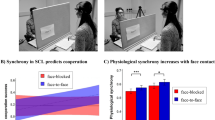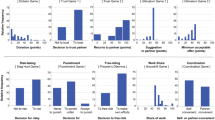Abstract
While economic standard theory explains cooperation in terms of rational decision-making, empirical studies suggest that humans have social preferences for cooperating with others. We investigated the specificity of these social preferences for interactions with human, relative to non-human, agents in a prisoner’s dilemma game. To obtain insights into emotional processes during cooperation, we measured activity of the corrugator supercilii muscle as indicator of spontaneous emotional responding during cooperation. After unreciprocated defection (free-riding), participants switched more often to a cooperative strategy and showed increased corrugator activity (suggesting more negative emotional responses) when playing with a human relative to a computer. This suggests that humans have a specific preference for cooperating with other humans and that cooperation may be promoted by unpleasant affect in response to the outcome of one’s own “free-riding”.




Similar content being viewed by others
References
Axelrod, R., & Hamilton, W. D. (1981). The evolution of cooperation. Science, 211(4489), 1390–1396.
Brainard, D. H. (1997). The Psychophysics Toolbox. Spatial Vision, 10(4), 433–436.
Brosnan, S. F., Salwiczek, L., & Bshary, R. (2010). The interplay of cognition and cooperation. Philosophical Transactions of the Royal Society B: Biological Sciences, 365(1553), 2699–2710.
Cacioppo, J. T., Petty, R. E., Losch, M. E., & Kim, H. S. (1986). Electromyographic activity over facial muscle regions can differentiate the valence and intensity of affective reactions. Journal of Personality and Social Psychology, 50(2), 260–268.
Camerer, C. F. (2003). Behavioral game theory: Plausible formal models that predict accurately. Behavioral and Brain Sciences, 26(2), 157–158.
Chen, X., Hackett, P. D., DeMarco, A. C., Feng, C., Stair, S., Haroon, E., … Rilling, J. K. (2015). Effects of oxytocin and vasopressin on the neural response to unreciprocated cooperation within brain regions involved in stress and anxiety in men and women. Brain Imaging and Behavior, 10(2), 581–593.
Croson, R., & Gneezy, U. (2009). Gender differences in preferences. Journal of Economic Literature, 47(2), 448–474.
Declerck, C. H., Boone, C., & Kiyonari, T. (2014). No place to hide: When shame causes proselfs to cooperate. Journal of Social Psychology, 154(1), 74–88.
Dimberg, U. (1990). Facial electromyography and emotional reactions. Psychophysiology, 27(5), 481–494.
Dimberg, U., & Petterson, M. (2000). Facial reactions to happy and angry facial expressions: Evidence for right hemisphere dominance. Psychophysiology, 37(5), 693–696.
Dunning, D. (2017). Normative goals and the regulation of social behavior: The case of respect. Motivation and Emotion. https://doi.org/10.1007/s11031-017-9616-8.
Fehr, E., & Camerer, C. F. (2007). Social neuroeconomics: The neural circuitry of social preferences. Trends in Cognitive Sciences, 11(10), 419–427.
Fridlund, A. J., & Cacioppo, J. T. (1986). Guidelines for human electromyographic research. Psychophysiology, 23(5), 567–589.
Hu, S., & Wan, H. (2003). Imagined events with specific emotional valence produce specific patterns of facial EMG activity. Perceptual and Motor Skills, 97(3 Pt 2), 1091–1099.
Ketelaar, T., & Au, W. T. (2003). The effects of feelings of guilt on the behaviour of uncooperative individuals in repeated social bargaining games: An affect-as-information interpretation of the role of emotion in social interaction. Cognition & Emotion, 17(3), 429–453.
Kuo, W. J., Sjostrom, T., Chen, Y. P., Wang, Y. H., & Huang, C. Y. (2009). Intuition and deliberation: Two systems for strategizing in the brain. Science, 324(5926), 519–522.
Larsen, J. T., Norris, C. J., & Cacioppo, J. T. (2003). Effects of positive and negative affect on electromyographic activity over zygomaticus major and corrugator supercilii. Psychophysiology, 40(5), 776–785.
Milinski, M., & Wedekind, C. (1998). Working memory constrains human cooperation in the Prisoner’s Dilemma. Proceedings of the National Academy of Sciences of the United States of America, 95(23), 13755–13758.
Rand, D. G. (2017). Social dilemma cooperation (unlike dictator game giving) is intuitive for men as well as women. Journal of Experimental Social Psychology (forthcoming). Available at SSRN: https://ssrn.com/abstract=2722981.
Rand, D. G., Brescoll, V. L., Everett, J. A., Capraro, V., & Barcelo, H. (2016). Social heuristics and social roles: Intuition favors altruism for women but not for men. Journal of Experimental Psychology: General, 145(4), 389–396.
Rilling, J., Gutman, D., Zeh, T., Pagnoni, G., Berns, G., & Kilts, C. (2002). A neural basis for social cooperation. Neuron, 35(2), 395–405.
Rilling, J. K., DeMarco, A. C., Hackett, P. D., Thompson, R., Ditzen, B., Patel, R., & Pagnoni, G. (2012). Effects of intranasal oxytocin and vasopressin on cooperative behavior and associated brain activity in men. Psychoneuroendocrinology, 37(4), 447–461.
Rilling, J. K., Gutman, D., Zeh, T., Pagnoni, G., Berns, G., & Kilts, C. (2002). A neural basis for social cooperation. Neuron, 35(2), 395–405.
Rilling, J. K., Sanfey, A. G., Aronson, J. A., Nystrom, L. E., & Cohen, J. D. (2004). Opposing BOLD responses to reciprocated and unreciprocated altruism in putative reward pathways. Neuroreport, 15(16), 2539–2543.
Sakaiya, S., Shiraito, Y., Kato, J., Ide, H., Okada, K., Takano, K., & Kansaku, K. (2013). Neural correlate of human reciprocity in social interactions. Frontiers in Neuroscience, 7, 239.
Soutschek, A., Sauter, M., & Schubert, T. (2015). The importance of the lateral prefrontal cortex for strategic decision making in the Prisoner’s dilemma. Cognitive, Affective, & Behavioral Neuroscience, 15(4), 854–860.
Soutschek, A., & Schubert, T. (2016). The importance of working memory updating in the Prisoner’s dilemma. Psychological Research, 80(2), 172–180.
Trivers, R. L. (1971). Evolution of reciprocal altruism. Quarterly Review of Biology, 46(1), 35–57.
Weinreich, A., Strobach, T., & Schubert, T. (2015). Expertise in video game playing is associated with reduced valence-concordant emotional expressivity. Psychophysiology, 52(1), 59–66.
Acknowledgements
We are grateful to Nadja Wiebe, Angelique Zessin, and Antonia Papadakis for help with data collection.
Author information
Authors and Affiliations
Corresponding authors
Ethics declarations
Conflict of interest
The authors declare no conflicting financial interests.
Ethical approval
All procedures performed in this study were in accordance with the ethical standards of the institutional research committee and with the declaration of Helsinki and its later amendments.
Informed consent
Informed consent was obtained by all participants included in the study.
Rights and permissions
About this article
Cite this article
Soutschek, A., Weinreich, A. & Schubert, T. Facial electromyography reveals dissociable affective responses in social and non-social cooperation. Motiv Emot 42, 118–125 (2018). https://doi.org/10.1007/s11031-017-9662-2
Published:
Issue Date:
DOI: https://doi.org/10.1007/s11031-017-9662-2




